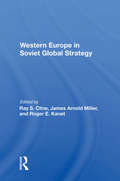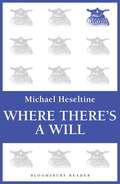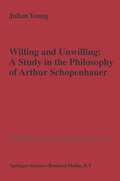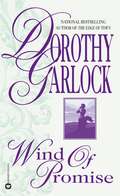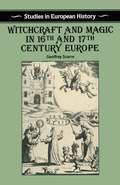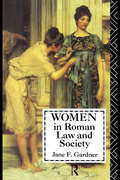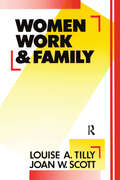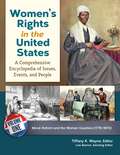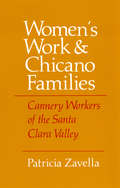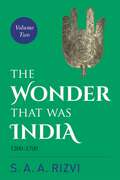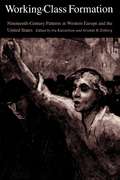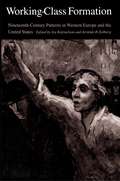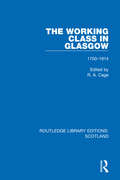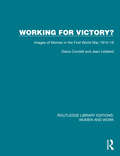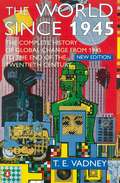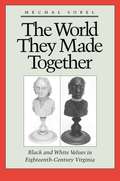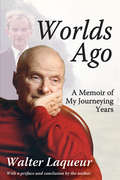- Table View
- List View
Western Europe In Soviet Global Strategy
by Ray S. ClineSoviet global strategy, long established and well understood by the Kremlin leaders, is to intimidate weak and fearful governments, exploit indigenous difficulties, disrupt social order, and promote communist revolutions. In this volume, European and American scholars describe the USSR's land and sea targets on and surrounding West Europe, where t
Where the Sea Breaks (The\scottish Collection)
by John PrebbleA German bomber crash-lands on a small Scottish island and the Nazi pilot, with his crew of three, seizes control of the place. Two guns are stripped from the wreckage; an inquisitive collie-dog is killed; a young man is shot dead beside his radio . . . and ‘martial law’ is declared. As thundering seas cut off the island from the mainland, John Prebble works out this wartime story to its terrifying climax. Methodically, brutally the Nazi officer shapes his plans; dumbly, sullenly the Scottish folk hold out and bide their time. Whose nerves will be the first to crack?
Where There's a Will
by Michael HeseltineWhen Where There's a Will was published in the early Spring of 1987 it received not only a highly favourable review coverage but, rarely for a work of political analysis, reached Number One in the Sunday Times best-seller lists. Michael Heseltine revised the book including a totally new chapter, bringing his reflections up to date and giving his thoughts on events of the Spring and Summer of a highly political year. Where There's a Will is a personal testament, a book of ideas, an autobiographical reassessment. It includes many illustrations from Michael Heseltine's personal life and also his views on the need for a British industrial strategy, the real meaning of the North-South divide, the underlying challenge of the inner cities and the proper role and management of government in attacking these and other problems. He faces the reality of continuing high levels of unemployment, sets out his vision of our relationship with the Superpowers. His prescription is one of radical reform, carried out with energy, efficiency and a sense of genuine partnership.
Willing and Unwilling: A Study in the Philosophy of Arthur Schopenhauer (Nijhoff International Philosophy Series #33)
by J.P. YoungWind of Promise (Wind Series #3)
by Dorothy GarlockVanessa is determined to cross the prairies, ford the mighty rivers and climb the Rockies to reach Colorado. But her resolve weakens when a tall, lean stranger as wild as the western wind takes her in his arms. Will surrender to this restless roamer bring her happiness - or will it break her heart forever.
Witchcraft and Magic in Sixteenth- and Seventeenth-Century Europe (Studies in European History)
by Geoffrey ScarreWolf In Shadow: The Graphic No (Jon Shannow Novel #1)
by David Gemmell'THE HARD-BITTEN CHAMPION OF BRITISH HEROIC FANTASY' - Joe Abercrombie 'HEROISM AND HEARTBREAK . . . GEMMELL IS ADRENALINE WITH SOUL' - Brent Weeks It is three hundred years since the world toppled on its axis and civilisation was destroyed. In this savagely reshaped world ruled by brigands and war-makers, a rider seeks a lost city. Pursuing a dream to calm the violence in his soul, Jon Shannow, the brigand slayer, desires only peace. But from the Plague Lands emerges a fresh terror.The Lord of the Pit and his hellborn army seek to plunge mankind into a new demonic era. Seemingly invincible, they make a fatal mistake: they take Shannow's woman for blood sacrifice. And find themselves facing the deadliest warrior of the new age. Jon Shannow - the Jerusalem Man.Novels by David GemmellThe Drenai seriesLegend The King Beyond the GateWaylanderQuest For Lost Heroes Waylander II: In the Realm of the WolfThe First Chronicles of Druss the LegendJon Shannow seriesWolf in ShadowThe Last GuardianBloodstone Stones of Power Ghost KingLast Sword of Power Hawk Queen seriesIronhand's DaughterThe Hawk Eternal Ancient Greece novelsLion of MacedonDark Prince Other novelsKnights of Dark RenownMorningstar
Women in Roman Law and Society
by Jane F. GardnerThe legal situation of the women of ancient Rome was extremely complex, and - since there was no sharp distinction between free woman, freedwoman and slave - the definition of their legal position is often heard. Basing her lively analysis on detailed study of literary and epigraphic material, Jane F. Gardner explores the provisions of the Roman laws as they related to women.Dr Gardner describes the ways in which the laws affected women throughout their lives - in families, as daughters, wives and parents; as heiresses and testators; as owners and controllers of property; and as workers. She looks with particular attention at the ways in which the strict letter of the law came to be modified, softened, circumvented, and even changed, pointing out that the laws themselves tell us as much about the economic situation of women and the range of opportunities available to them outside the home.
Women in Roman Law and Society
by Jane F. GardnerThe legal situation of the women of ancient Rome was extremely complex, and - since there was no sharp distinction between free woman, freedwoman and slave - the definition of their legal position is often heard. Basing her lively analysis on detailed study of literary and epigraphic material, Jane F. Gardner explores the provisions of the Roman laws as they related to women.Dr Gardner describes the ways in which the laws affected women throughout their lives - in families, as daughters, wives and parents; as heiresses and testators; as owners and controllers of property; and as workers. She looks with particular attention at the ways in which the strict letter of the law came to be modified, softened, circumvented, and even changed, pointing out that the laws themselves tell us as much about the economic situation of women and the range of opportunities available to them outside the home.
Women, Work and Family
by Joan W. Scott Louise A. TillyFirst published in 1987. Routledge is an imprint of Taylor & Francis, an informa company.
Women, Work and Family
by Joan W. Scott Louise A. TillyFirst published in 1987. Routledge is an imprint of Taylor & Francis, an informa company.
Women's Rights in the United States [4 volumes]: A Comprehensive Encyclopedia of Issues, Events, and People [4 volumes]
by Tiffany K. Wayne Lois BannerA comprehensive encyclopedia tracing the history of the women's rights movement in the United States from the American Revolution to the present day.Few realize that the origin of the discussion on women's rights emerged out of the anti-slavery movement of the 19th century, and that suffragists were active in the peace and labor movements long after the right to vote was granted. Thus began the confluence of activism in our country, where the rights of women both followed—and led—the social and political discourse in America. Through 4 volumes and more than 800 entries, editor Tiffany K. Wayne, with advising editor Lois Banner, examine the issues, people, and events of women's activism, from the early period of American history to the present time. This comprehensive reference not only traces the historical evolution of the movement, but also covers current issues affecting women, such as reproductive freedom, political participation, pay equity, violence against women, and gay civil rights.
Women's Work and Chicano Families: Cannery Workers of the Santa Clara Valley (The Anthropology of Contemporary Issues)
by Patricia ZavellaAt the time Women’s Work and Chicano Families: Cannery Workers of the Santa Clara Valley was published, little research had been done on the relationship between the wage labor and household labor of Mexican American women. Drawing on revisionist social theories relating to Chicano family structure as well as on feminist theory, Patricia Zavella paints a compelling picture of the Chicano women who worked in northern California’s fruit and vegetable canneries. Her book combines social history, shop floor ethnography, and in-depth interviews to explore the links between Chicano family life and gender inequality in the labor market.
The Wonder That Was India: Volume 2
by S. A. RizviS. A. A. Rizvi’s The Wonder That Was India (Volume Two) is a groundbreaking enquiry into the history of India during the period of Islamic political dominance in the subcontinent. Through meticulous research and painstaking study, Rizvi pieces together a comprehensive account of the five hundred years between the thirteenth and eighteenth centuries, detailing the political histories of the Arabs, Turks, Afghans and Mughals. From his exploration of the social and economic conditions, the state, religion and the fine arts, a vibrant picture emerges of a massive and fertile exchange that would influence the destiny of more than a billion people. This volume, along with A. L. Basham’s classic The Wonder That Was India (Volume One), offers an extensive and engrossing view of the pre-colonial history of India.
Working-Class Formation: Ninteenth-Century Patterns in Western Europe and the United States
by Ira Katznelson Aristide R. ZolbergApplying an original theoretical framework, an international group of historians and social scientists here explores how class, rather than other social bonds, became central to the ideologies, dispositions, and actions of working people, and how this process was translated into diverse institutional legacies and political outcomes. Focusing principally on France. Germany, and the United States, the contributors examine the historically contingent connections between class, as objectively structured and experienced, and collective perceptions and responses as they develop in work, community, and politics. Following Ira Katznelson's introduction of the analytical concepts, William H. Sewell, Jr., Michelle Perrot, and Alain Cottereau discuss France; Amy Bridges and Martin Shefter, the United States; and Jargen Kocka and Mary Nolan, Germany. The conclusion by Aristide R. Zolberg comments on working-class formation up to World War I, including developments in Great Britain, and challenges conventional wisdom about class and politics in the industrializing West.
Working-Class Formation: Ninteenth-Century Patterns in Western Europe and the United States
by Ira Katznelson Aristide R. ZolbergApplying an original theoretical framework, an international group of historians and social scientists here explores how class, rather than other social bonds, became central to the ideologies, dispositions, and actions of working people, and how this process was translated into diverse institutional legacies and political outcomes. Focusing principally on France. Germany, and the United States, the contributors examine the historically contingent connections between class, as objectively structured and experienced, and collective perceptions and responses as they develop in work, community, and politics. Following Ira Katznelson's introduction of the analytical concepts, William H. Sewell, Jr., Michelle Perrot, and Alain Cottereau discuss France; Amy Bridges and Martin Shefter, the United States; and Jargen Kocka and Mary Nolan, Germany. The conclusion by Aristide R. Zolberg comments on working-class formation up to World War I, including developments in Great Britain, and challenges conventional wisdom about class and politics in the industrializing West.
The Working Class in Glasgow: 1750-1914 (Routledge Library Editions: Scotland #4)
by R. A. CageOriginally published in 1987, this book examines how much industrialisation improved the standard of living of the British worker, based on the experience of one representative city: Glasgow. It analyses whether there was an increase in skilled as opposed to unskilled labour in major industrial centres – as for example in Glasgow, manufacturing shifted from textiles to engineering. Other important issues such as the rate of housing construction, public health, local politics and leisure pursuits are also considered. Glasgow has a long history of working-class culture and is therefore a particularly interesting city to study.
The Working Class in Glasgow: 1750-1914 (Routledge Library Editions: Scotland #4)
by R. A CageOriginally published in 1987, this book examines how much industrialisation improved the standard of living of the British worker, based on the experience of one representative city: Glasgow. It analyses whether there was an increase in skilled as opposed to unskilled labour in major industrial centres – as for example in Glasgow, manufacturing shifted from textiles to engineering. Other important issues such as the rate of housing construction, public health, local politics and leisure pursuits are also considered. Glasgow has a long history of working-class culture and is therefore a particularly interesting city to study.
Working for Victory?: Images of Women in the First World War, 1914–18 (Routledge Library Editions: Women and Work)
by Diana Condell Jean LiddiardWomen ‘kept the home fires burning’ while their men went off to war. This is the usual image of the part played by women in the First World War, reinforced through countless posters, government exhortations and even popular songs. It is very far from the truth. As this remarkable book shows, originally published in 1987, the truth was that women showed themselves capable of undertaking many roles hitherto the sole prerogative of men, a position accepted during the emergency of war but quickly ‘righted’ once peace was restored: the women who had helped to win the war were displaced by the returning heroes from the Front. Diana Condell and Jean Liddiard selected more than 150 superb contemporary photographs, and these unique pictures, with extended captions and accompanying text, illustrate the many and varied roles played by women in the First World War. Many of the photographs had never been published before and they reveal dramatically the extent to which women took over the day-to-day running of society during the war. Fulfilling these roles helped to change women’s perceptions of themselves and their place in the social fabric: the photographs are arranged thematically to reveal this and how society’s own view of women was altered as a result. The book also tells the story of the war from the female viewpoint, assessing its effect on the women involved. It focuses in a neglected but vital part of the history of the emancipation of women and also raises questions about what sort of victory they had worked for. In quality and range this was a pioneering study. More than that, through the haunting quality of its images it creates a pathway into the mind and world of the past.
Working for Victory?: Images of Women in the First World War, 1914–18 (Routledge Library Editions: Women and Work)
by Diana Condell Jean LiddiardWomen ‘kept the home fires burning’ while their men went off to war. This is the usual image of the part played by women in the First World War, reinforced through countless posters, government exhortations and even popular songs. It is very far from the truth. As this remarkable book shows, originally published in 1987, the truth was that women showed themselves capable of undertaking many roles hitherto the sole prerogative of men, a position accepted during the emergency of war but quickly ‘righted’ once peace was restored: the women who had helped to win the war were displaced by the returning heroes from the Front. Diana Condell and Jean Liddiard selected more than 150 superb contemporary photographs, and these unique pictures, with extended captions and accompanying text, illustrate the many and varied roles played by women in the First World War. Many of the photographs had never been published before and they reveal dramatically the extent to which women took over the day-to-day running of society during the war. Fulfilling these roles helped to change women’s perceptions of themselves and their place in the social fabric: the photographs are arranged thematically to reveal this and how society’s own view of women was altered as a result. The book also tells the story of the war from the female viewpoint, assessing its effect on the women involved. It focuses in a neglected but vital part of the history of the emancipation of women and also raises questions about what sort of victory they had worked for. In quality and range this was a pioneering study. More than that, through the haunting quality of its images it creates a pathway into the mind and world of the past.
World Encompassed: First European Maritime Nations, C.800-1650 (PDF)
by G. V. ScammellIn this authoritative study Geoffrey Scammell traces the course of European expansion between about 800 and 1650, during which time the world known to western Europeans was enlarged in a way unparalleled before or since...
World Encompassed: First European Maritime Nations, C.800-1650 (PDF)
by G. V. ScammellIn this authoritative study Geoffrey Scammell traces the course of European expansion between about 800 and 1650, during which time the world known to western Europeans was enlarged in a way unparalleled before or since...
The World Since 1945: The Complete History Of Global Change From 1945 To The End Of The Twentieth Century (Pelican Ser.)
by T. VadneyTHE COMPLETE HISTORY OF GLOBAL CHANGE FROM 1945 TO THE PRESENT DAY The world since 1945 has witnessed fundamental changes, notably the increasing influence of the West - particularly the USA - in a variety of spheres, the emergence and collapse of the USSR, the end of colonial empire in Asia and Africa and the escalation of wars and other conflicts in the Third World. In this incisive survey T. E. Vadney examines the key events without ever neglecting the underlying trends. He explores therapid changes in the Middle East, the end of apartheid in South Africa and the aims of American foreign policy. He concludes with a new epilogue in which he examines the direction of post-1945 history as the world enters the twenty-first century.
The World They Made Together: Black and White Values in Eighteenth-Century Virginia
by Mechal SobelIn the recent past, enormous creative energy has gone into the study of American slavery, with major explorations of the extent to which African culture affected the culture of black Americans and with an almost totally new assessment of slave culture as Afro-American. Accompanying this new awareness of the African values brought into America, however, is an automatic assumption that white traditions influenced black ones. In this view, although the institution of slaver is seen as important, blacks are not generally treated as actors nor is their "divergent culture" seen as having had a wide-ranging effect on whites. Historians working in this area generally assume two social systems in America, one black and one white, and cultural divergence between slaves and masters.It is the thesis of this book that blacks, Africans, and Afro-Americans, deeply influenced white's perceptions, values, and identity, and that although two world views existed, there was a deep symbiotic relatedness that must be explored if we are to understand either or both of them. This exploration raises many questions and suggests many possibilities and probabilities, but it also establishes how thoroughly whites and blacks intermixed within the system of slavery and how extensive was the resulting cultural interaction.
Worlds Ago: A Memoir of My Journeying Years
by Walter LaqueurOriginally published in 1993, Worlds Ago is not only about the politics of the times, but also about the world into which Walter Laqueur was born and raised and the world that shaped him: pre-war Germany in 1921, where he witnessed the rise of the Nazi party. It is a story of families, friendships, and early love; achievements and disappointments; and facing and surviving dangerous circumstances in which many of those close to him lost their lives. It was a world where calm seas and waters were rare and survivors were lucky to escape the engines of war.This memoir further recounts his experience as an agricultural laborer on a kibbutz, in what was Palestine at the time, living among Bedouin and Arab herdsmen, sharing their labor and lifestyle. Laqueur became a journalist and writer in his twenties, and witnessed dramatic events in the Middle East and the emergence of Israel in the aftermath of World War II. He came to know many of the leading figures on both sides who were involved in the establishment of the State of Israel. Walter Laqueur went on to become one of the leading historians and interpreters of the Weimar period in Germany. This new edition, revised to tell his story up until 1948, also includes a new preface and conclusion.
